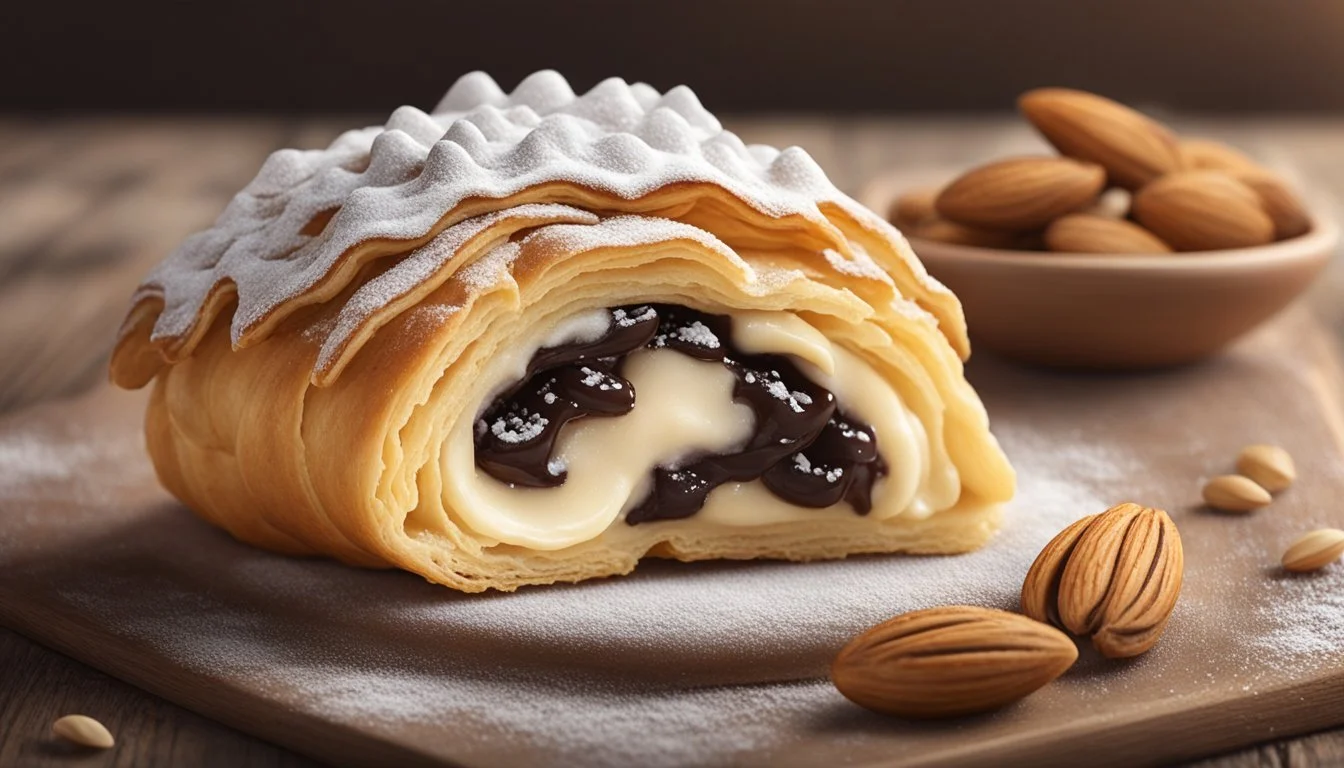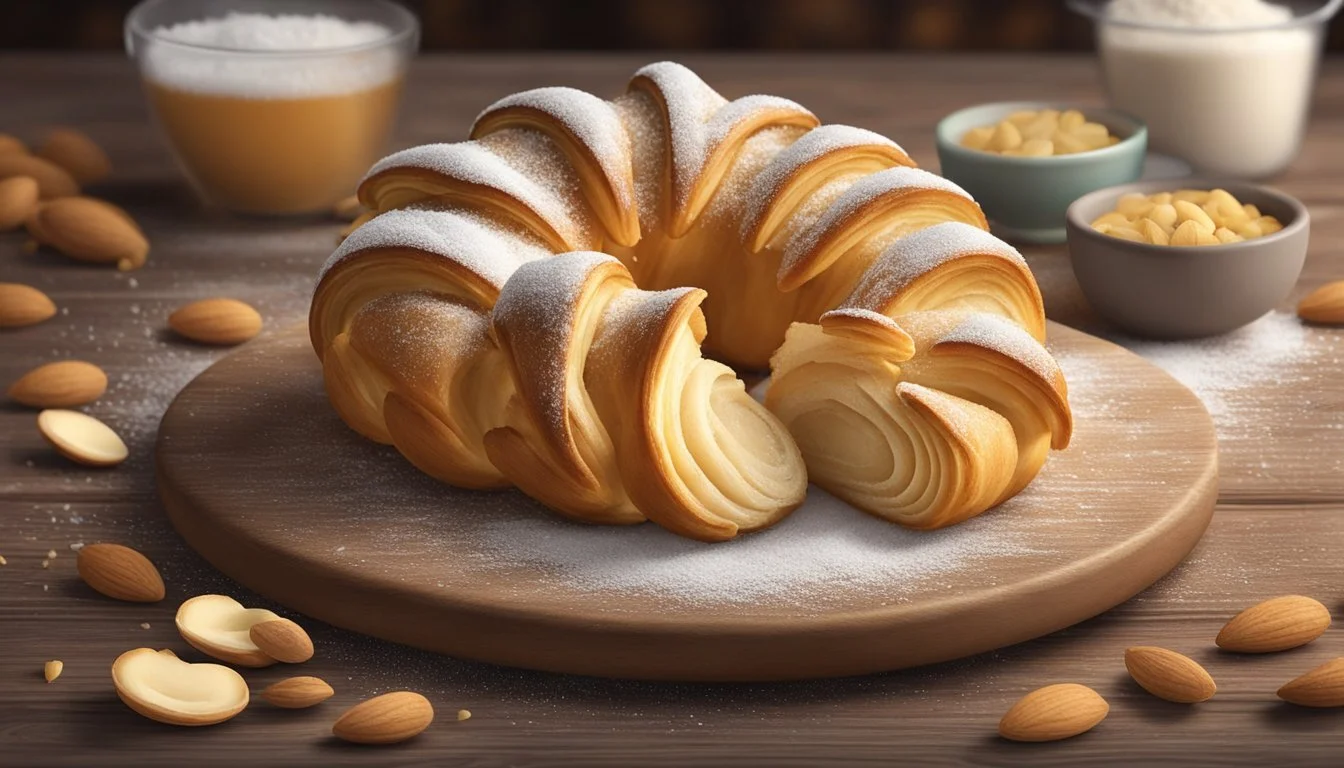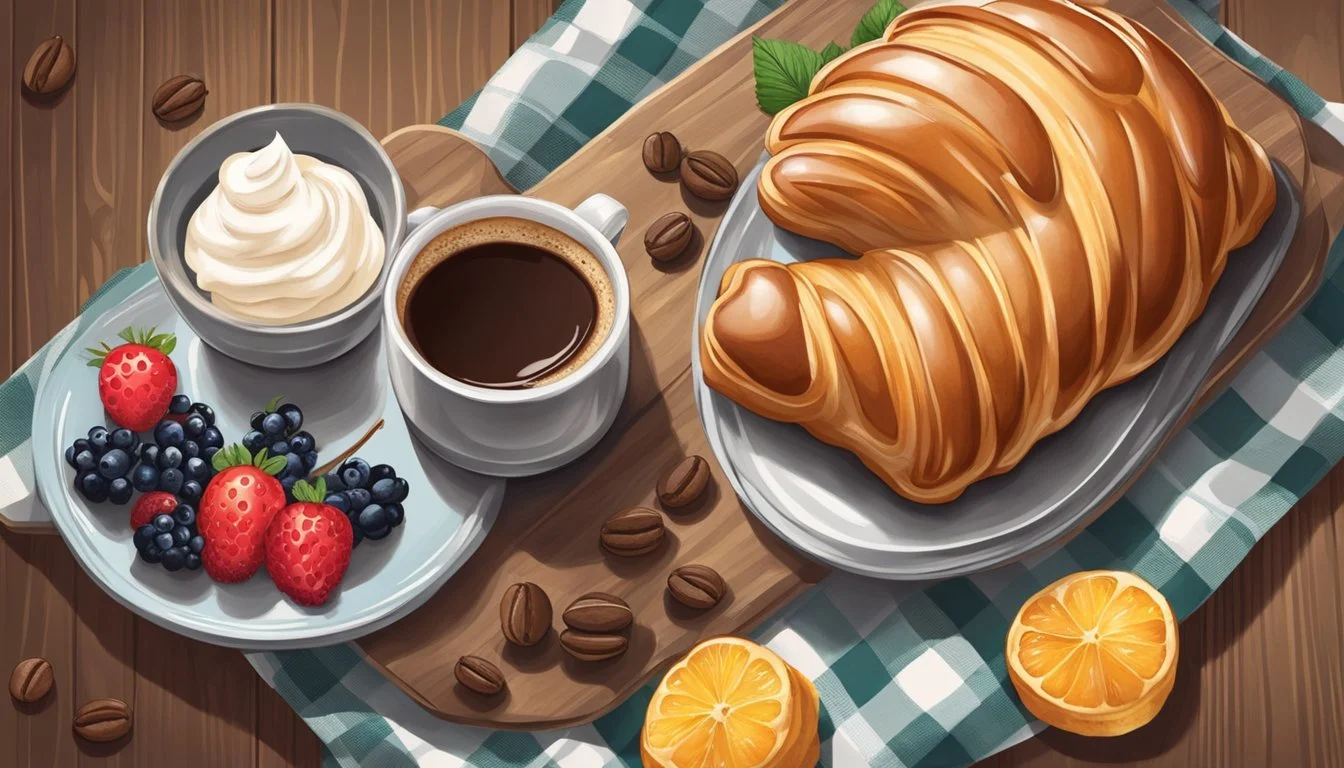Bear Claw Pastry
Unraveling the Mystery Behind the Delightful Moniker
The Bear Claw pastry offers a rich and flavorful experience with every bite. This delightful sweet, shaped to mimic the formidable appendage of its namesake, traces its origins to the United States—specifically to the early 20th century. Crafted with a luxurious, buttery dough, its most recognizable feature, apart from the shape, is the delectable filling loaded with finely chopped almonds, sugar, and often enriched with the sweet, aromatic essence of almond extract.
Unlike the claw of an actual bear, this pastry's appeal lies in its inviting texture, ranging from a fluffy, raised dough to a crisp, flaky finish reminiscent of puff pastry. Throughout its history, the Bear Claw has seen numerous iterations, with various fillings enhancing its core recipe. It has firmly established itself as a beloved staple across American bakeries, relished by patrons of all ages seeking a comforting treat to accompany their morning coffee or to savor during a leisurely break.
The art of preparing a Bear Claw goes beyond the ingredients, focusing on the technique that creates the pastry's notable segments, mimicking a bear's paw. This characteristic design not only adds to its visual charm but also allows for a more dynamic texture with its craggy surface enabling the pastry to catch sugary glazes or a dusting of powdered sugar to perfection. With its combination of pleasing aesthetics and sumptuous taste, the Bear Claw continues to be a cherished confection within American culinary tradition.
History and Origins
The bear claw is a pastry with a lineage that pays homage to traditional Danish baking while also showcasing its unique adaptation in the United States.
Influence of Danish Pastries
The Danish influence on pastries is significant, giving rise to a variety of sweet, flaky treats enjoyed worldwide. The bear claw, in particular, shares similarities with the kamme, a Danish pastry known for its comb-like shape. These offerings have crossed borders and led to inspired variants, emphasizing the universal appeal of Danish confectionery ingenuity.
Popularity in the United States
In the early 20th century, Californian bakers created their spin on these European delicacies. The bear claw earned its name from its distinct shape, reminiscent of a bear's paw. First attested in 1914, the Geibel German Bakery in Los Angeles is credited with popularizing the pastry. Its sweet fillings and texture made it a bakery favorite across the United States, enhancing its standing as a beloved breakfast or dessert option. Over time, the bear claw became synonymous with American pastry innovation, retaining its identity amid the changing tastes of consumers.
The Anatomy of a Bear Claw
A Bear Claw pastry is a delightful combination of flaky layers, rich fillings, and a unique shape that resembles the paw of its namesake animal. Its construction is both an art and a science, involving specific baking techniques and ingredient choices.
Understanding Puff Pastry
The foundation of a Bear Claw is puff pastry. This light and flaky pastry is made from alternating layers of dough and butter, which, during baking, cause the pastry to rise distinctively due to the water in the butter turning into steam. The process to create these layers is known as lamination. The dough expands and separates into many thin layers, resulting in puff pastry's characteristic texture that is both crispy and tender.
The Significance of Almond Paste
A key component of the filling is almond paste, which provides a sweet, nutty flavor to the Bear Claw. Almond paste is made from ground almonds, sugar, and a binding agent such as egg whites. The rich taste and moist texture of almond paste complement the flakiness of the puff pastry, leading to a balanced and indulgent experience.
Distinctive Arc Shape
The Bear Claw is notable for its distinctive arc shape, which gives it its name. The pastry is typically cut into rectangles, then slits are made to resemble a claw. The dough is then fanned out into sections, forming an arc that mirrors the paw of a bear. This arc is not merely decorative; it also allows the pastry to bake evenly, provides texture contrast, and ensures that each bite contains the perfect ratio of puff pastry to almond filling.
Ingredients Detail
The Bear Claw Pastry is composed of a multitude of ingredients that come together to create its distinct sweet and nutty flavor, as well as its flaky texture. Highlighting both the essential components and room for creativity, let's examine the specifics of what goes into this treat.
Key Ingredients
Flour: The foundation of the dough, providing structure.
Sugar: Adds sweetness and affects browning.
Butter: Unsalted butter is preferable for flavor and creating flaky layers.
Eggs: Provide richness and help to bind the dough.
Yeast: Often used in the dough for leavening, contributing to a light texture.
Almonds: A classic nut used both inside the pastry and as a topping for added crunch and flavor.
Optional Additions and Variants
While the traditional bear claw is well-loved for its simplicity, bakers often experiment with additional ingredients to create variants:
Spices: Cinnamon, nutmeg, and cardamom can be incorporated for enhanced warmth and complexity.
Extracts: A few drops of almond extract can intensify the almond-forward flavor.
Cheese: Cream cheese can be used for a richer filling.
Chocolate or Custard: These can be included for a sweet variation of the traditional filling.
Exploring Sweet Fillings
Variety in fillings allows for customizing the bear claw to individual tastes. The filling usually combines almond paste with other ingredients to amplify its sweet and creamy characteristics:
Almond paste and chopped almonds for a pronounced nutty essence.
Sweeteners: More sugar may be added for extra sweetness.
Binding agents: Egg whites help hold the filling together.
Fruit and Jam: Some recipes may incorporate raisins, other dried fruits (What wine goes well with dried fruits?), or fruit jams to complement the almond filling.
Custard or Chocolate: A dollop of smooth custard or rich melted chocolate can be swirled in for those with a sweeter tooth.
Preparation Instructions
Creating a Bear Claw pastry entails a few essential steps: mixing and kneading dough, shaping and cutting to give the pastry its characteristic look, and baking until it achieves a golden perfection. This section offers instructions that respect tradition while delivering on the delightful texture and taste Bear Claws are known for.
Mixing and Kneading Dough
The base of a Bear Claw starts with the dough. Bakers should whisk together the dry ingredients, typically inclusive of flour, a leavening agent, sugar, and a pinch of salt. Wet ingredients—like milk, butter, eggs, and possibly almond extract for added flavor—are gradually introduced into the dry mixture. The goal is to mix until just combined. Overworking the dough can result in toughness, so one should knead it only until it forms a smooth ball before proceeding to flatten it slightly on a floured surface.
Shaping and Cutting Techniques
Once the dough is prepared, it's rolled into a rectangle, ensuring a consistent thickness. A sharp knife or pastry cutter is employed to divide the dough into squares or rectangles dependent on the desired size of the pastries. Bakers then place a strip of almond filling near the bottom of each piece. To create the 'claw' effect, several small diagonal cuts are made in the dough above the filling. As a tip, some find it easier to transfer the pastry to the baking sheet before slashing the dough—this can help prevent tearing. The final shape is achieved by bending the pastry into a slight curve and separating the 'claws'.
Baking to Perfection
The oven should be preheated to the optimal temperature, usually around 400°F (205°C), to ensure a crisp and golden crust on the pastries. Before they go into the oven, a glaze or egg wash can be applied to the surface for a glossy finish. The bear claws typically require baking until they're well-puffed and possess a rich golden-brown color. When done, they should be allowed to cool slightly before serving. If an icing is preferred, it can be drizzled over the warm pastries. For storage, one should keep them in an airtight container to maintain freshness.
Variations and Innovations
This section explores the various interpretations of Bear Claw pastries, from home kitchens to global influences, and how contemporary alternatives are expanding its appeal.
Homemade vs. Store-Bought
Homemade Bear Claw pastries often feature handcrafted dough, where bakers might opt for store-bought puff pastry to save time. When made at home, the characteristic texture of the Bear Claw can be achieved with a layered approach, using butter and meticulously folding the dough to create the pastry's flaky exterior. Sliced almonds and almond paste filling offer a classic touch, with the filling's creamy texture contrasting the crisp exterior.
Regional Delicacies
Each region has its take on the classic Bear Claw. For instance, in Denmark, the pastry is known as a kam or spandauer, often filled with almond cream or custard. Other European versions echo the original French technique used in croissants, tweaking the shape and filling to suit local tastes. Variations may include not just almonds but also fruit fillings and various icings, adapting the pastry to regional flavor profiles.
Modern Twists and Alternatives
In the current culinary scene, Bear Claw pastries embrace innovation. Chefs and bakers are experimenting with alternative fillings, such as chocolate chips, various fruit jams, or cream cheese mixtures. Gluten-free and vegan options are also emerging, substituting traditional ingredients with plant-based butters and gluten-free flours to cater to dietary restrictions without sacrificing flavor. These modern iterations ensure the Bear Claw's evolution continues, making it a versatile confectionery delight across diverse palates.
Pairings and Serving Suggestions
When indulging in a Bear Claw pastry, its rich flavors and textures are best complemented by certain beverages and accompaniments. Selecting the right pairings can transform the pastry experience from a simple treat to a delightful, multi-sensory indulgence.
Beverage Companions
Coffee: A hot cup of coffee, especially a robust dark roast, cuts through the sweetness while accentuating the pastry's almond notes.
Espresso: Intense and concentrated, an espresso pairs exquisitely, especially during breakfast hours.
Cappuccino/Latte: The creamy milk in these beverages rounds off the Bear Claw's buttery flakiness, suitable for brunch (What wine goes well with brunch?) or dessert.
Milk: A cold glass of milk complements the Bear Claw's tender crumb and provides a refreshing contrast to the richness.
Whole Milk: Its full-bodied texture balances the pastry's flakiness.
Almond Milk: For a non-dairy option, almond milk echoes the almond flavor in the pastry.
Accompaniments for a Complete Treat
Fruits: Fresh seasonal berries or a lightly spiced apple compote can add a tart contrast to the sweet pastry.
Nuts: (What wine goes well with nuts?) A side of toasted almonds or walnuts can intensify the nutty flavor and add a different texture to snack on.
Cheese: A slice of mild cheese, such as brie or cream cheese, can add a savory note to the sweet and rich pastry when served as breakfast or brunch.
Nutritional Information
A typical Bear Claw pastry weighs in at a substantial calorie count, most commonly ranging from 500 to 527 calories per serving. The majority of these calories stem from the pastry’s significant carbohydrate and fat content. On average, the carbohydrates in one serving amount to approximately 50 to 60 grams. Sugar, a notable carbohydrate in Bear Claws, contributes to the sweet flavor profile of the pastry, with quantities varying by recipe or manufacturer.
Regarding fat content, the Bear Claw is considerable, providing about 23 to 26 grams of total fat. The fat composition includes a mix of saturated, polyunsaturated, and monounsaturated fats. Saturated fat in one pastry can be around 6.9 grams, which is a substantial portion of the daily value for this type of fat.
For those who consider dietary details, it's essential to note that the pastry also contains cholesterol and proteins, with cholesterol levels hovering around 162mg. This is a significant amount, which represents a considerable percentage of the recommended daily intake for cholesterol.
The nutritional profile of a Bear Claw pastry can vary based on preparation methods and the choice of ingredients in the filling. However, as a general rule, this treat is best enjoyed in moderation due to its rich and indulgent nature. Those with dietary restrictions or health-conscious goals should be aware of the pastry's nutritional denseness.
Preservation and Storage
Proper preservation and storage are crucial for maintaining the quality and taste of Bear Claw pastries. The shelf life of these pastries is significantly impacted by factors like ingredient freshness and storage conditions.
Best Practices for Freshness
Bear Claw pastries should be consumed within 24 to 48 hours when left at room temperature to maintain optimal freshness. They should be stored in an airtight container to prevent them from drying out and to protect them from contaminants. Butter and egg—key ingredients in Bear Claw pastries—can spoil quickly, so it's essential to minimize exposure to air and moisture which can lead to mold and staleness.
At Room Temperature:
Store in airtight containers.
Keep away from direct sunlight and heat sources.
In the Refrigerator:
Place pastries in airtight containers or wrap tightly with plastic wrap.
Consume refrigerated pastries within 3-4 days.
Long-term Storage Solutions
For those who wish to keep Bear Claw pastries for an extended period, freezing is the best option. Freezing can extend a pastry's shelf life for up to three months without significant loss of flavor or texture. For optimal results, individually wrap each pastry in plastic wrap followed by foil to prevent freezer burn.
Freezing Pastries:
Individually wrap pastries in plastic and foil.
Place wrapped pastries in a freezer-safe bag or container.
Label with the date of freezing.
To thaw, one should move the pastries from the freezer to the refrigerator, letting them defrost slowly overnight. Before serving, pastries can be briefly warmed in an oven to restore the pastry's flakiness. It is important not to refreeze Bear Claws after thawing to prevent deterioration of quality.







